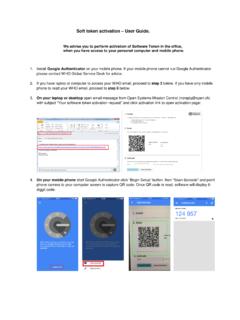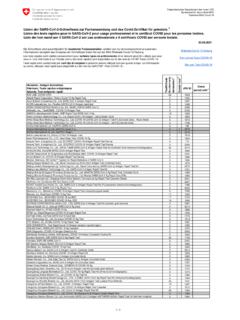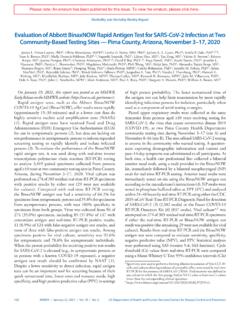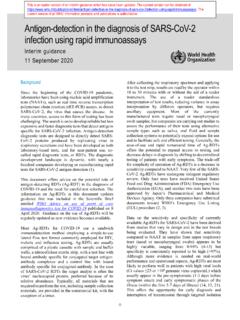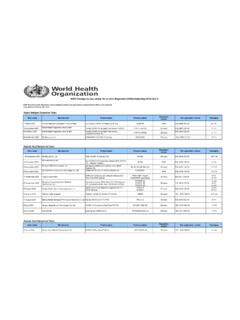Transcription of How to Do a SARS-CoV-2 Antigen Rapid Diagnostic Test
1 How to Do a SARS-CoV- 2 antigen rapid Diagnostic TestSample collection, testing and interpretation of SARS-CoV-2 Antigen RDTsREAD THE MANUFACTURERS INSTRUCTIONS CAREFULLY BEFORE YOU BEGINP reparation for sample (unopened) individually wrapped sterile nasopharyngeal protective equipment-Gloves, gown, eye protection or face shield & medical for marking or labellingPreparation for SARS-CoV-2 Antigen testing (unopened) COVID-19 Antigen Test buffer tube and nozzle waste container (Bleach and Alcohol)Sample collectionInsert a sterile nasopharyngeal swab into the nasal cavity of the patient, reaching the surface of the posterior nasopharynxSwab over the surface of the posterior nasopharynx, rotating the swab 3 4 times to ensure a good sample. Leaving the swab in the nasal cavity for a few seconds will ensure absorption of the nasal secretions Withdraw the sterile swab from the nasal cavitySARS-CoV-2 Antigen testingInsert the swab into an extraction buffer tube.
2 While squeezing the buffer tube, stir the swabRemove the swab while squeezing the sides of the tube to extract the liquid from the swabPress the nozzle cap tightly onto the tubeApply the drops of extracted specimen to the specimen well of the test device. Add the exact number of drops specified by the manufacturerRead and record the test result after the specified period. Report the test resultDispose of the gloves, test device, swab and extraction buffer tube in the medical waste container. Disinfect the workstation with bleach and alcoholInterpretation of the test resultPositiveA line in C AND a line in T means SARS-CoV-2 is DETECTEDN egativeA line in C and NO LINE in T means SARS-CoV-2 is NOT DETECTEDI nvalidNO LINE in C and a line or no line in T means the test is INVALID. Repeat the test using a new (unopened) SARS-CoV- 2 antigen test device and a new sampleProduced by the Foundation for Innovative New Diagnostics (FIND) from COVID-19 Antigen RDT manufactures Instructions for Use.
3 Guidance on content was obtained from the World Health Organization (WHO) Antigen -detection in the diagnosis of SARS-CoV-2 infection using Rapid immunoassays-Interim guidance (11 September 2020)
